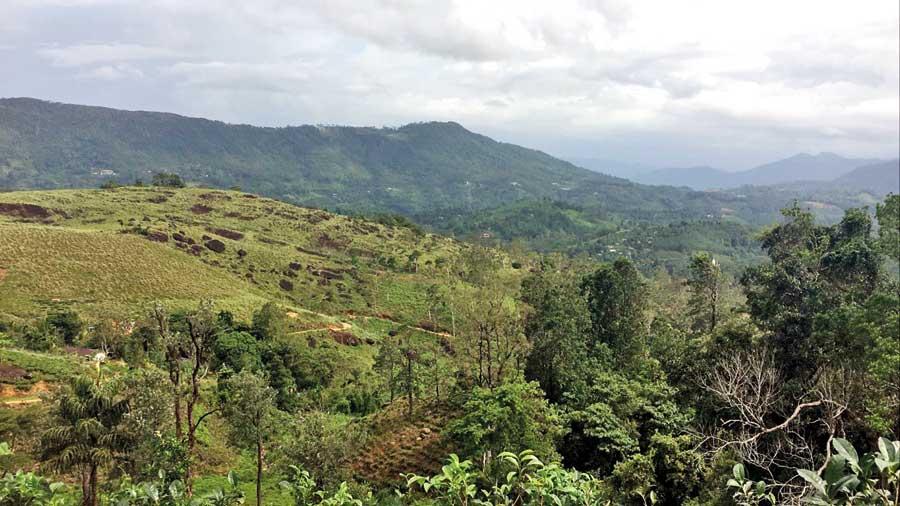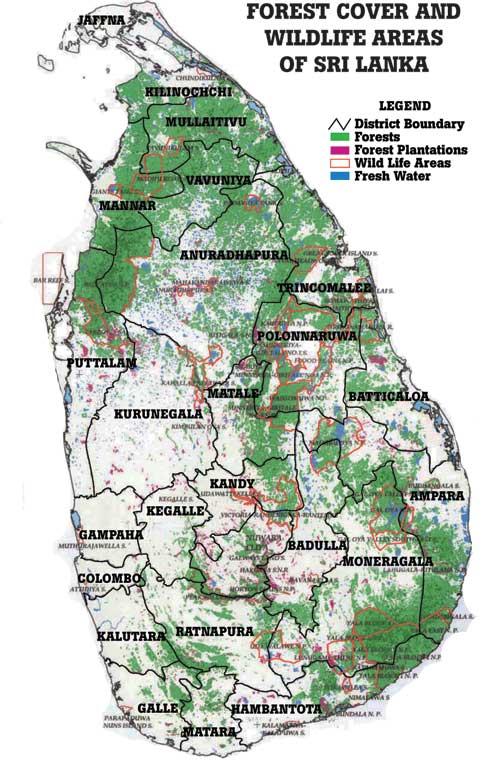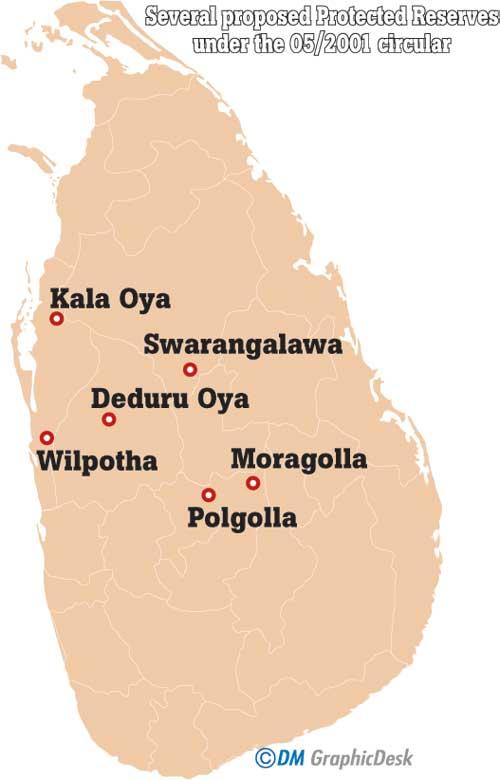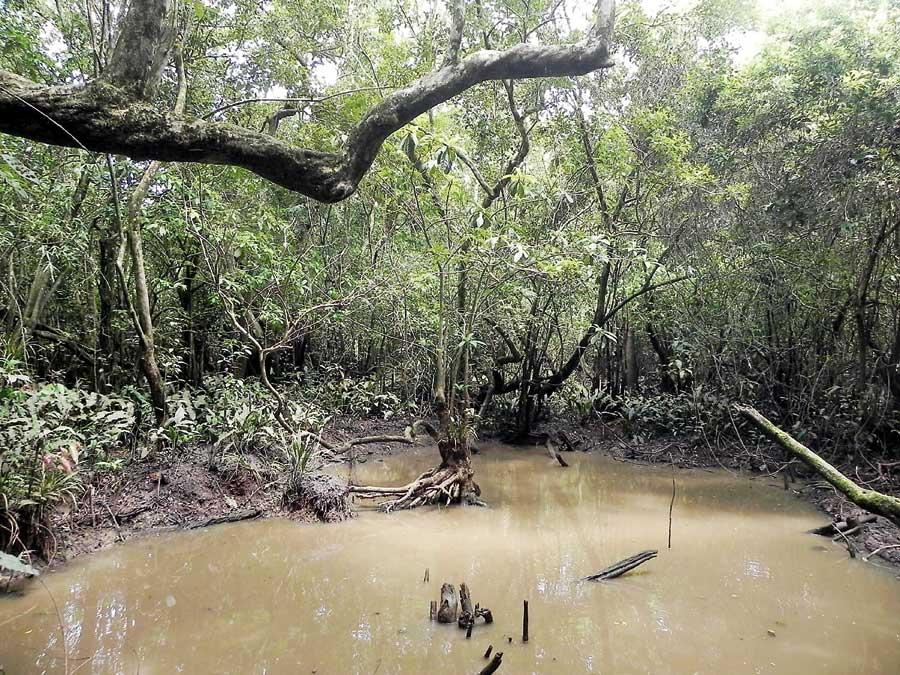08 Jul 2020 - {{hitsCtrl.values.hits}}
500,000 hectares of forest land in danger

Revoking the Circular will pose a threat to endemic species living in other state forests.
Sri Lanka’s wildlife and environment are experiencing a rough patch and environmentalists have been up in arms  ever since. From increased snaring to the human-elephant conflict, approving questionable projects in sensitive ecosystems devoid of Environmental Impact Assessments, giving the go-ahead for activities such as sand and rock mining to deforestation in forest lands, the list seems to be endless. The most recent development is the government’s plan to amend Circular No. 05/2001 in order to give authority back to District and Divisional Secretaries to transfer lands to non-state entities for economic purposes. Therefore, the Department of Forest Conservation (DFC) will not have an authority to assess whether it’s a critical area or not, prior to the land being given away.
ever since. From increased snaring to the human-elephant conflict, approving questionable projects in sensitive ecosystems devoid of Environmental Impact Assessments, giving the go-ahead for activities such as sand and rock mining to deforestation in forest lands, the list seems to be endless. The most recent development is the government’s plan to amend Circular No. 05/2001 in order to give authority back to District and Divisional Secretaries to transfer lands to non-state entities for economic purposes. Therefore, the Department of Forest Conservation (DFC) will not have an authority to assess whether it’s a critical area or not, prior to the land being given away.
“Prior to the issuance of the 05/2001 circular, forest patches in state lands were unprotected,”opined Jayantha Wijesinghe, convener of Rainforest Protectors, Sri Lanka. “These lands came under the purview of DFC, Department of Wildlife Conservation (DWC), Divisional Secretaries and Government Agents. But the Divisional Secretaries and Government Agents heavily misused these lands giving away residential and various other types
|
Bandula Barb |
of permits. In fact these forest patches were nameless and people used to call them ‘muukalana’. In order to stop this misuse, the 05/2001 circular was issued and they were once again under the purview of the DFC. This circular therefore prevented Divisional Secretariats from transferring the ownership of these areas to non-state entities at their own discretion,” explained Wijesinghe.
Wijesinghe said that by revoking this circular it will affect around 500,000 hectares of land which would go back to unprotected status. “We have an abundance of savannahs, dry zone forests, montane forests, rainforests which will soon be transferred if this circular is amended or removed. Not an inch of land should be changed at this point. When the lands were used by GAs people they were utilised for coconut, sugarcane, paddy, cotton and other cultivation purposes.
Today Divisional Secretaries are issuing agri permits for people in areas such as Moneragala, Anuradhapura and Puttalam and many acres of land are being cleared. This is what happened at the Flood Plains National Park where permits were issued by Thamankaduwa DS for people to do farming activities inside this Park,” said Wijesinghe.
He questioned how the Government would increase forest cover by 3% when they are going to destroy half a million hectares this way. “If they want to use land they could use agriculture lands. According to the Land Use Planning Department survey, out of the 33% of agri lands only 12% is being used efficiently and effectively. Apart
|
Decorated Ace |
from that there are acres of abandoned land in Kalmunai, Jaffna, Kurunegala and many other areas,” he added.
Drawing his concerns over the consequences of revoking the circular Environmental Lawyer Jagath Gunawardana said that Divisional Secretaries don’t have a mechanism to give away these lands without causing damage to the environment. “The 02/2006 circular released other state lands which they could use for development purposes,” said Gunawardena.
However according to him, forest lands that come under the purview of the 05/2001 circular include :
Watersheds of tributaries and canals
They help maintain the groundwater table
Repositories of biological diversity
An abundance of endemic species who have adapted to these ecosystems
Speaking further on endemic species under threat Gunawardana spoke about the Bandula Barb (Petiya bandula) a freshwater fish found in a small patch of forests at the Rabbidigala Hill in Kegalle District. “If this area is used for developmental purposes this fish would become extinct. Another threatened freshwater fish species is the Wilpita Rasbora. Another butterfly species is the Decorated Ace (Thoressa decorata), the male species of an endemic
 This circular therefore prevented Divisional Secretariats from transferring the This circular therefore prevented Divisional Secretariats from transferring the ownership of these areas to non-state entities - Jayantha Wijesinghe |
butterfly found in the wet zone. Other threatened species include amphibians, geckos and orchids endemic to other state forests. Apart from that crop wild relatives which are important in developing new varieties of plants too will be threatened,” said Gunawardana.
Proposed Protected Reserves under the 05/2001 circular include Swarangalawa, Kala Oya, Galkuliya, Sangappale, Wilpotha , Etaritiya, Mudungoda, Minuwangeta (Deduru Oya), Manewa Kanda, Proposed Gatadivula Eco Park, Alutabandawewa, Nugampola, Moturampatana, Digalla, Habilikanda, Moragolla, Polgolla and Yatale.
During the Cabinet meeting held last Wednesday a decision was taken to transfer lands which are considered to be ‘residual forests’ to District and Divisional Secretariats. Announcing the decision, joint Cabinet spokesperson Bandula Gunawardena said that the provisions included in the 05/2001 circular have resulted in ‘long procedures’ for the use of these lands for ‘other purposes’. He further requested the Minister of Environment and Wildlife Resources to propose a mechanism to vest powers in the District and Divisional Secretaries to give away such lands on a temporary basis while they remain to be state-owned lands for economically productive activities without causing damage to the environment.
However, Gunawardena further stressed that the term ‘residual forest’ is a misnomer. “Residue means waste and this gives an impression that these forests are useless and that they could be used for developmental purposes. This is a mischievous terminology the government has used to serve their purpose,” he said.

According to Hemantha Withanage, Executive Director at Centre for Environmental Justice, this circular was amended by the circular no. 02/2006 for releasing barren lands which are not forest lands. “Therefore if lands are needed for state development activities this circular fulfills that requirement. But if they remove the 05/2001 circular it’s going to be a joke,” he affirmed.
He further said that the 05/2001 circular includes critical areas such as elephant corridors, catchment areas and other sensitive ecosystems which would be destroyed if the circular is removed. “Already damage has been done to several of these lands in areas such as Bathmitiyawa, Mullegama and Kandasurindugama. Some of them were also used for the Gam Udawa programme as well. In fact 150 out of 250 elephant corridors have been destroyed due to the Gam Udawa programme.
Apart from that there are 16 areas which are yet to be declared as elephant corridors. If lands are given following the removal of this circular, these elephant corridors would be destroyed. However we have observed that the authority of the DWC and DFC overlaps in most instances and the DWC is awaiting the DFC to take action. So what we are now trying to do is sit with environmentalists, civil society groups and academics and propose a criterion to bargain with the Government and show them the areas they cannot take,” said Withanage.
 If this area is used for developmental purposes this fish would become extinct. Another threatened freshwater fish species is the Wilpita Rasbora - Jagath Gunawardana If this area is used for developmental purposes this fish would become extinct. Another threatened freshwater fish species is the Wilpita Rasbora - Jagath Gunawardana |
When contacted, Ministry of Environment and Wildlife Resources Secretary A.H.S Wijesinghe said that the circular will not be revoked. “A proposal has been made to draw a mechanism to give away lands on a temporary basis. But the final decision will be taken at the Cabinet meeting scheduled for this Wednesday (July 8),” said Wijesinghe.
The National Forest Policy of 1980 saw the start-up of forestry activities for environmental benefit, and people’s participatory social forestry. However, there were no direct references in the NFP to poverty alleviation or social development.
An initial Forestry Master Plan (FMP) was drawn up in Sri Lanka in 1986 with the support of the World Bank and Finnish International Development Agency (FINNIDA). It was described as an ‘investment programme’, drawn up without participation and was never implemented.
In 1988, the National Conservation Strategy recommended the cessation of haphazard alienation of natural forests. Under the National Environmental Act (1988), all the forestry development projects were subject to an environmental impact assessment prior to approval in order to safeguard against adverse environmental
 Therefore if lands are needed for state development activities the 02/2006 circular fulfills that requirement. But if they remove the 05/2001 circular it’s going to be a joke - Hemantha Withanage Therefore if lands are needed for state development activities the 02/2006 circular fulfills that requirement. But if they remove the 05/2001 circular it’s going to be a joke - Hemantha Withanage |
consequences.
A 1995 assessment done by Christopher Legg and Nicholas Jewell indicated that Sri Lanka has lost its closed canopy cover from about 84 percent in 1881 to about 23.9 percent in 1992 due to conversion to other types of land use, such as human settlements, plantation crops, agriculture and shifting cultivation. It further revealed that thirteen districts (Ampara, Anuradhapura, Badulla, Batticaloa, Gampaha, Hambantota, Kandy, Kilinochchi, Kurunegala, Moneragala, Polonnaruwa, Trincomalee and Vavuniya) have suffered loss of forest while the rest of the 10 districts (Colombo, Galle, Jaffna, Kalutara, Kegalle, Mannar, Matara, Mullaittivu, Puttalam, and Ratnapura districts) show increase in their forest cover.
They also indicate that the remaining forests are mostly dry monsoon forests, sparse forests and fragments of tropical rain forests.
Large-scale forest tree planting in Sri Lanka started in late 1950’s and till December 1996 has covered about 135,052 hectares of forest plantations, of which, about 87,000 hectares belong to the Forest Department. The main plantation species are Teak, Eucalyptus (mainly Eucalyptus grandis), Pine (Pine caribaea) and Mahogany.
Most of the fuel wood (Eucalyptus camaldulensis, E. tereticornis and Acacias), miscellaneous hardwood and teak  plantations are located in the dry zones of Sri Lanka. The Eucalyptus (mainly E. grandis, but also E. microcorys, E. globulus and E. robusta) and Pines (P. caribaea and P. patula) plantations are mostly in the upland and in the Galle and Ratnapura forest divisions. The Mahogany plantations are situated in Kurunegala and Kegalle civil districts. Planting of Teak was stopped in 1926 due to adverse silvicultural reports and was resumed again in 1939 in patana (natural grassland).
plantations are located in the dry zones of Sri Lanka. The Eucalyptus (mainly E. grandis, but also E. microcorys, E. globulus and E. robusta) and Pines (P. caribaea and P. patula) plantations are mostly in the upland and in the Galle and Ratnapura forest divisions. The Mahogany plantations are situated in Kurunegala and Kegalle civil districts. Planting of Teak was stopped in 1926 due to adverse silvicultural reports and was resumed again in 1939 in patana (natural grassland).
One of the major criticisms against the Forestry Master Plan of Sri Lanka (1986) was its failure to address the environmental aspects of forestry, particularly with regard to converting the country’s rapidly dwindling natural forests in the wet zone. Commonly referred to as the National Conservation Review (NCR), this component of the Environmental Management in Forestry Development Project (EMFDP) is concerned with evaluating all remaining natural forests (including mangrove) with respect to their importance for biodiversity, in terms of ecosystem and species diversity, and their value for soil and water conservation. Its over-riding objective is to define a national system of conservation forests in which watersheds important for soil conservation and hydrology are protected, forest biodiversity is fully represented and cultural, economic and social needs are met. Another relevant initiative was the preparation of a Biodiversity Conservation Action Plan for Sri Lanka, which commenced in 1996 following a planning phase in 1995. The biodiversity component of the Forestry Sector Master Plan, hence the NCR, fell within the framework of this Action Plan. The NCR followed on from an Accelerated Conservation Review (ACR) of 30 lowland rain forests, managed as 13 units and covering some 480 square kilometers (TEAMS, 1991). Scientific information on their conservation importance was urgently needed ahead of the NCR because these forests had been earmarked for logging.
The National Forest Policy (1995) and the National Wildlife Policy (1999) are the most recent key policy documents ruling the forestry sector.

Marsh forest which falls under Other Forest Land and is therefore protected under 05/2001 circular
Image courtesy: Jagath Gunawardana
28 Nov 2024 57 minute ago
28 Nov 2024 1 hours ago
28 Nov 2024 2 hours ago
28 Nov 2024 3 hours ago
28 Nov 2024 5 hours ago